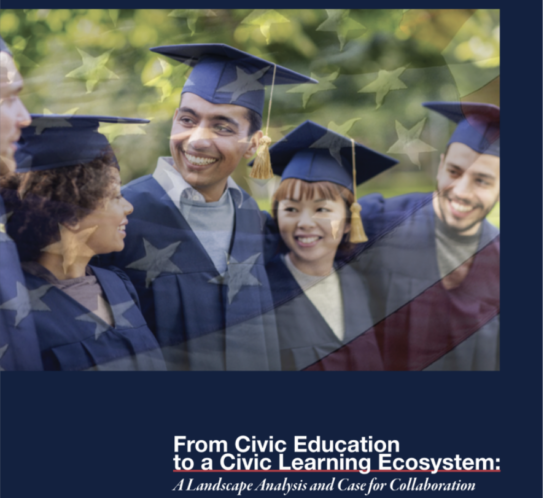From Civic Education to a Civic Learning Ecosystem
A Landscape Analysis and Case for Collaboration
Share
Downloads
This 2019 white paper, From Civic Education to a Civic Learning Ecosystem, authored by Citizens & Scholars president Raj Vinnakota provides a comprehensive landscape of the civic education space to understand how the work of funders, policymakers, educators, researchers, and nonprofit organizations comes together and interacts to produce our current system of civic education.
The report notes the surprising consensus among people ideologically diverse people in the civic education space that our current system of civic education needs to be reimagined and rebuilt for the 21st century.
There is a broad concern that our current patchwork system of high school classes, after-school programs, and online platforms is failing to produce enough young people who are well-informed, productively engaged in, and hopeful about our democracy.
While the words people use to describe the existing challenges and exactly what they hope to achieve vary, these three ideas are central. Almost everyone interviewed believes that a new, improved system of civic learning should be designed to produce citizens who are:
- civically well-informed (i.e., they have a nuanced understanding of our history, government, civil society institutions and current affairs)
- productively engaged for the common good (i.e., they are active in their communities and able to work with all kinds of people without fear or contempt to craft solutions to their common problems)
- hopeful about our democracy (i.e., they love their country for the lofty ideals it espouses, namely liberty and justice for all, while recognizing that we have often struggled to live up to those ideals)
The paper also provides a framework for conceptualizing and discussing shared goals and urges funders, educators, researchers, and the general public to develop a new, more robust conception of civic learning that goes well beyond the high school civics class.

Read the Report
This paper is part of a larger project to launch collaborative efforts to improve, expand and, energize civic learning in our country.
DownloadKey Findings
There is far more agreement about the ultimate aims of civic education than any of us imagined.
Of the hundreds of disparate organizations currently in the civic education and learning space, an almost uniform consensus was reached that the current system of civic education needs to be reimagined and rebuilt for the 21st century.
We need to think beyond the high school civics class to imagine a lifetime of civic learning and practice.
The civic learning field must include young people from 0–24 and span learning opportunities in K–12, higher education, out-of-school-time organizations, communities, digital spaces, families, and religious institutions.
To develop and implement a new and improved system of civic learning, we need to build the field of civic learning.
We must consider the entire ecosystem of civic learning. Each place where civic learning happens relies on the other. If society doesn’t prioritize civic learning, schools and other institutions will not either.
Collaboration will not always be easy, but it is the only way forward.
Change depends on a coalition of partners from across the ideological spectrum committed to doing this work together.
Stay Engaged
Get More Resources
Join our mailing list for new resources and tools right in your mailbox.
Support Our Work
Help us invest in the talent, ideas, and networks that will develop young people as effective, lifelong citizens.
Ways to Support